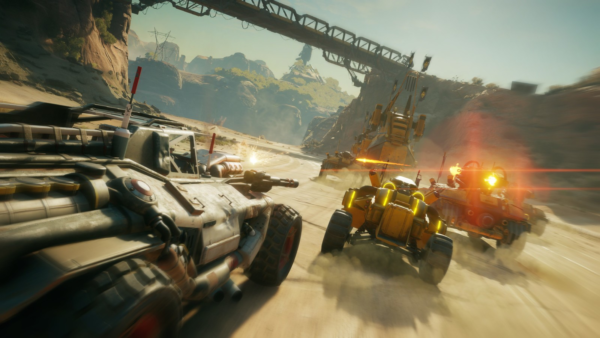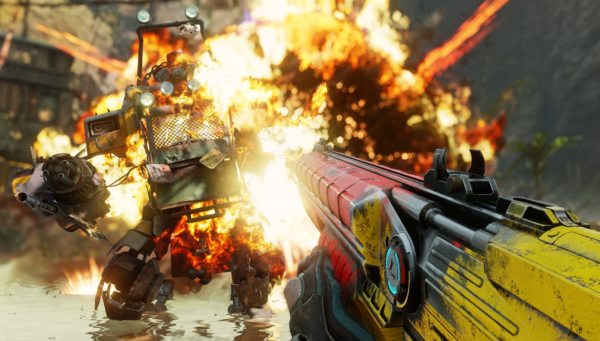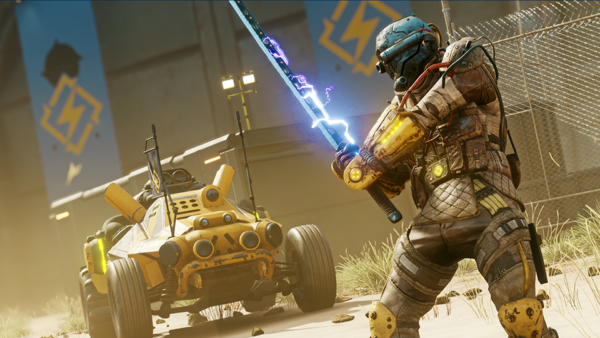Video Game Review: “Rage 2” — Time to Rage on
By Michael Costa
This wide-angle richness — a world filled with things to do, myriad side-distractions — is the mark of exceptional game design.

Rage 2’s focus on vehicular combat differentiates it from id’s other games.
Of all the games that will be released this year, Rage 2 made an unusually surprising appearance. Many players had decided to abandon id software’s opening installment, despite its positive reviews. Rage became notorious for serving up one of the most abrupt and unsatisfying endings in video game history. With id’s repertoire of legendary IPs (intellectual properties), including Wolfenstein, Doom, and Quake — the latter two with massive sequels still in development — it is mind-boggling that a Rage 2 team was given any resources. That being said, I adored the first game (barring the frustrating ending, of course) and was excited about what the studio would come up with. Avalanche Studios was assigned to do the bulk of the game’s development, which was a good sign. Many were impressed by AS’s 2015 project, Mad Max — the studio’s take on the popular post-apocalyptic film franchise. Mad Max had its flaws, and it seems that some of these issues have spilled over into this new title.
The game display of Rage 2 is shiny, colorful, and boasts spectacular visual effects. Unfortunately, the character models didn’t receive the same treatment; some protagonists look sparsely detailed and blurry. The sound effects create an overwhelmingly hellacious soundscape: raining gunfire, chaining explosions, revved engines, electric blasts, and breaking of bones. The soundtrack is ambient and understated, though it creeps in occasionally to generate some atmosphere during downtime. The specs on this game vary depending on the console it’s played on, but it can run comfortably on 60 FPS, which maintains a new bar for consoles. Performance issues reported on release range from audio bugs to game-breaking loops that forced some players to restart the entire campaign. A big, open-world game is expected to have some of these pitfalls, though the numerous bugs in Rage 2 point to developers waiting for the 30-days post-release patch to fix them.
Rage 2 can be categorized as a post-apocalyptic first-person shooter with RPG elements (such as upgrades and skill trees). However, most of the action’s emphasis is on vehicular combat. According to id Studio Director Tim Willits, Rage comes from shortening the word “garage.” This focus on vehicles differentiates the Rage series from id’s other games. This will probably puzzle players of either Rage, because both are at their weakest when it comes to providing the kind of nuanced driving mechanics that are critical for the player to use to navigate the game’s enviornment.

Each bout of combat is an opportunity to experiment with weapon combos and (new to the series) character super powers.
There’s a great variety of vehicles to choose from, but to succeed the player must figure out which of the vehicles offer effective handling. What use is it to frequently veer off a cliff or into a bunch of trees? These problems are fixed with the mid-game appearance of the Icarus, a small wasteland hovercraft that can be used almost anywhere to carry the player quickly over the world’s rough terrain. Regardless, why are the other vehicles such clunkers?
Despite the car trouble, the combat in Rage 2 is impressive. The first-person shooting opportunities are satisfying. Each situation offers the potential to experiment with weapon combinations and (new to the series) character super powers. The enemy factions include: the River Hogs, The Abadon Mutants, the Goon Squad, the Immortal Shrouded, and the principal enemy from the first game, the Authority. Each baddie provides distinctive challenges and varied battles — though none more so than the Immortal Shrouded, with their invisible, headshot-immune, katana-wielding soldiers that sport reinforcing barriers on their bodies and vehicles. Given these impressive villains, it doesn’t matter that the storyline is somewhat lackluster.
The narrative’s premise: recruit three members (of earlier failed battles) to take out the Authority for good. Whether the player chooses a male or female character, the figure is motivated by revenge. Sadly, tired dialogue loops throughout the entire game. The payback-driven trio (human relics from the original Rage) don’t have much to do or say. Players take on two missions (albeit long ones) from each original character before moving on to a final mission. Then the game’s main story ends. That’s a decidedly short amount of playtime for a first-person shooter. Many players were frustrated by this; because I expected the quick shuffle beforehand, I put the major missions off. Instead, I focused on side-missions and open-world exploration. These elements are still accessible, even after the end of the final mission. It is odd that so many lower-difficulty side missions can be pursued — given that they have (seemingly) no story-engineered purpose. It isn’t surprising that many players didn’t anticipate this unusual arrangement — they zipped through the main story in five hours and then put the game down for good.

Immortal Shrouded Bandit clan members add to the challenge in Rage 2 gameplay.
I completed the main story after 32 hours. I paced myself, and took the time to explore the environment. I would accept a mission, and then something along the way would catch my eye — bandit factions battling on the road, an unexplored location. This wide-angle richness — a world filled with things to do, myriad side-distractions — is the mark of exceptional game design. Avalanche and id released a road map filled with content alongside the game, including two expansions with more material to follow. Controversy, unpredictable vehicles, and (fixable) game bugs aside, Rage 2 has a lot of potential. Time to rage on.
Michael Costa holds a B.A. in English: Creative Writing, with a minor in History, from Lasell College. He is currently furthering his education at Emerson College, where he will be joining the M.F.A. Creative Writing program in Fall 2019. His creative resume includes: Managing Editor & Lead Designer for the Compendium Literary Arts Journal, contributor and editor for the Amalgam Digital record label, and contributor to the arts magazine, Tarnished.
